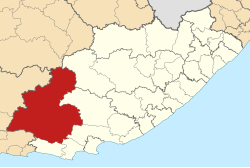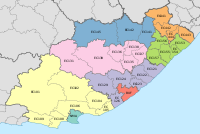Dr Beyers Naudé Local Municipality
Dr Beyers Naudé | |
|---|---|
 Location of the municipality within the Eastern Cape | |
| Country | South Africa |
| Province | Eastern Cape |
| District | Sarah Baartman |
| Seat | Graaff-Reinet |
| Wards | 14 |
| Government | |
| • Type | Municipal council |
| • Mayor | Deon de Vos (ANC) |
| • Speaker | Thembisa Nonnnes (ANC) |
| Area | |
| • Total | 28,653 km2 (11,063 sq mi) |
| Population (2011)[2] | |
| • Total | 79,291 |
| • Density | 2.8/km2 (7.2/sq mi) |
| Racial makeup (2011) | |
| • Black African | 23.6% |
| • Coloured | 66.9% |
| • Indian/Asian | 0.4 |
| • White | 8.7 |
| First languages (2011) | |
| • Afrikaans | 80.3% |
| • Xhosa | 14.8% |
| • English | 3.2% |
| • Other | 1.7% |
| Time zone | UTC+2 (SAST) |
| Municipal code | EC101 |
Dr Beyers Naudé Local Municipality is a new local municipality that was established by merging the Camdeboo, Ikwezi and Baviaans local municipalities in the Sarah Baartman District of the Eastern Cape in South Africa. The decision to merge the municipalities was taken by the Municipal Demarcation Board in 2015 but only took effect after municipal elections on 3 August 2016. The new municipality is named after the Afrikaner cleric and anti-apartheid activist Beyers Naudé.[3] Its seat is in Graaff-Reinet.
Geography and people
The new municipality covers an area of 28,653 square kilometres (11,063 sq mi) at the western end of the Eastern Cape province, from the Sneeuberge in the north to the Baviaanskloof in the south. It is a sparsely populated area, with a population of 79,291 giving a density of only 2.8 inhabitants per square kilometre (7.3/sq mi).[2]
80.3% of residents of the municipality speak Afrikaans as their home language, while 14.8% speak Xhosa and 3.2% speak English. 66.9% described themselves as "Coloured", 23.6% as "Black African", and 8.7% as "White".[2]
The principal town in the municipal area is Graaff-Reinet, with a population of approximately 35,000. Other towns include Willowmore, Aberdeen, Jansenville, Steytlerville and Klipplaat.
Government and politics
The municipal council consists of 27 members elected by mixed-member proportional representation. 14 councillors are elected by first-past-the-post voting in 14 wards, while the remaining 13 are chosen from party lists so that the total number of party representatives is proportional to the number of votes received. In the election of 3 August 2016 the African National Congress (ANC) won a narrow majority of 14 seats on the council.
The following table shows the results of the election.[4][5]
style="width: 2px; color:inherit; background-color: #006600;" data-sort-value="African National Congress" | style="width: 2px; color:inherit; background-color: #005BA6;" data-sort-value="Democratic Alliance (South Africa)" | style="width: 2px; color:inherit; background-color: #852A2A;" data-sort-value="Economic Freedom Fighters" | style="width: 2px; color:inherit; background-color: lightgrey;" data-sort-value="Service Delivery Organisation" | style="width: 2px; color:inherit; background-color: #DCDCDC;" data-sort-value="Independent (politics)" || Party | Votes | Seats | ||||||
|---|---|---|---|---|---|---|---|---|
| Ward | List | Total | % | Ward | List | Total | ||
| ANC | 12,561 | 12,607 | 25,168 | 51.1 | 8 | 6 | 14 | |
| DA | 11,504 | 11,466 | 22,970 | 46.6 | 6 | 7 | 13 | |
| EFF | 399 | 459 | 858 | 1.7 | 0 | 0 | 0 | |
| Service Delivery Organisation | 115 | 177 | 292 | 0.6 | 0 | 0 | 0 | |
| Independent | 14 | - | 14 | 0.0 | 0 | 0 | 0 | |
| Total | 24,593 | 24,709 | 49,302 | 100.0 | 14 | 13 | 27 | |
| Spoilt votes | 396 | 359 | 755 | |||||
References
- ^ http://www.rnews.co.za/article/10523/protest-delays-inauguration-at-new-ecape-municipality
- ^ a b c d e f Sum of the statistics from Census 2011 for Camdeboo, Ikwezi, and Baviaans.
- ^ Mngxitama-Diko, Avuyile (6 June 2016). "EC municipality to be named after Naudé". The Herald. Port Elizabeth. Retrieved 6 July 2016.
- ^ "Results Summary – All Ballots: Camdeboo" (PDF). Independent Electoral Commission. Retrieved 24 August 2016.
- ^ "Seat Calculation Detail: Camdeboo" (PDF). Independent Electoral Commission. Retrieved 24 August 2016.

